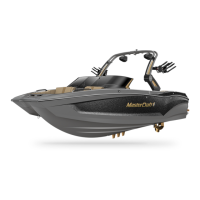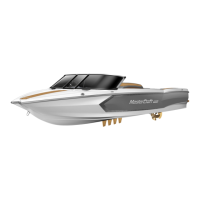A
B
L
C
J
E
F
G
H
K
I
MARISTAR
230
D
LENGTH OF BOAT: .............................................. 22’8”
OVERALL LENGTH W/TRAILER: ............................. 24’7”
WIDTH AMIDSHIP: .................................................... 98”
OVERALL WIDTH W/TRAILER ................................. 100”
HEIGHT W/TOWER FOLDED ON TRAILER (TA) . 92-1/2”
HEIGHT W/TOWER FOLDED ON TRAILER (SA) ......... 94”
BOAT WEIGHT: ............................ 3,300 LBS. (APPR OX.)
SINGLE AXLE TRAILER WEIGHT: ......................... 900 LBS.
TANDEM AXLE TRAILER WEIGHT: .................... 1,050 LBS.
FUEL CAPA CITY: ......................................... 60 GALLONS
CAPACITY: ........................... 12 PEOPLE OR 1,720 LBS.
1
2
3
4
5
6
7
8
9
10
11
12
13
14
15
16
17
18
19
20
1 OIL PRESSURE GAUGE
2 ENGINE TEMPERATURE GAUGE
3 MULTI-FUNCTION/TACHOMETER
4 CHECK ENGINE LIGHT
5 SPEEDOMETER OR PERFECT PASS
6 VOLTMETER
7 FUEL GAUGE
8 HORN
9 12-VOLT RECEPTACLE
10 GAUGE DISPLAY SELECTOR
11 SPEEDOMETER CALIBRATOR
12 BLOWER SWITCH
13 IGNITION KEY SLOT
14 STEREO INSERT
15 ACCESSORY 1 SWITCH
16 ACCESSORY 2 SWITCH
17 COUR TESY LIGHTS SWITCH
18 NAVIGATION/ANCHOR LIGHT SWITCH
19 BILGE PUMP SWITCH
20 ACCESSORY
A STERN
LIGHT
RECEPTACLE
B BLOWER
EXHAUST
CSWIM
PLATFORM
DFUEL
TANK
FILLER
E STORAGE
UNDER
SUN
PAD
F B ATTERY
(
BEHIND
SEAT
)
G T HROTTLE
/
SHIFT
CONTROL
H INSTRUMENT
PANEL
IBOW
LIGHT
J GLOVE
BOX
KSKI
LOCKER
L ENGINE
COMPARTME NT
M DRAIN
PLUGS
M

